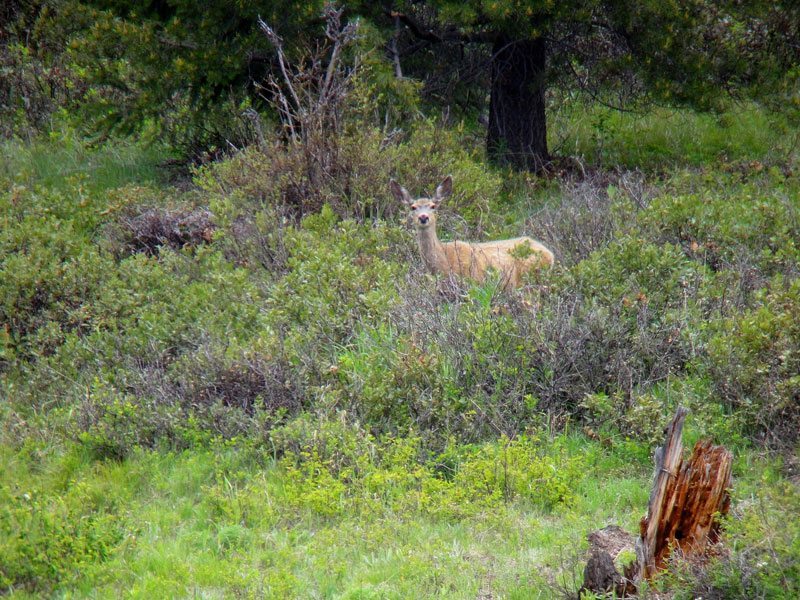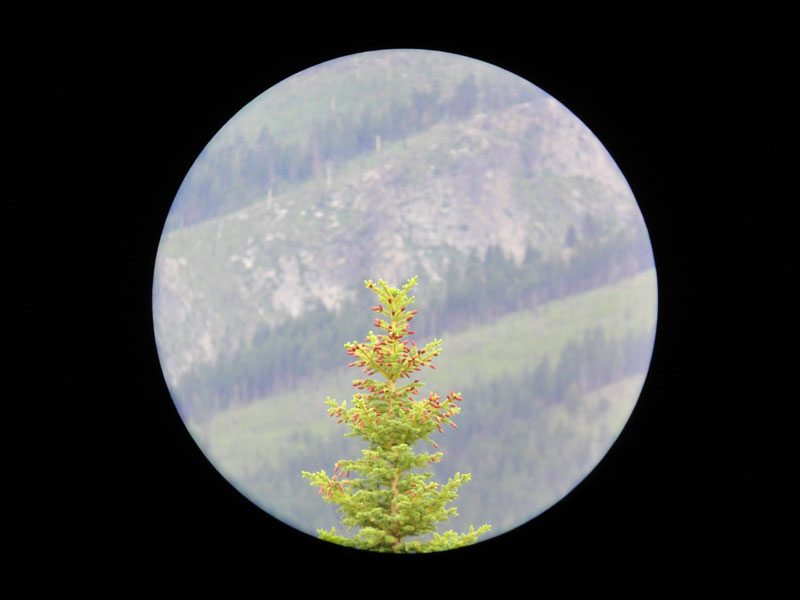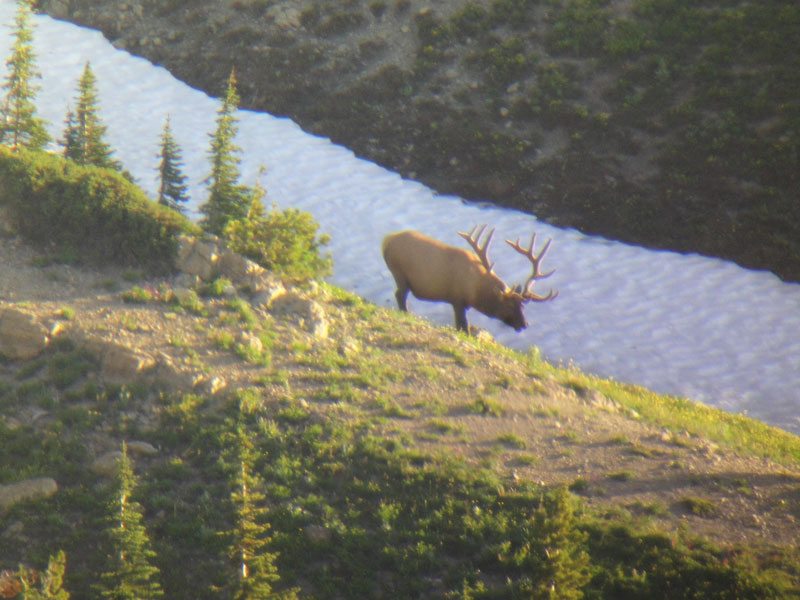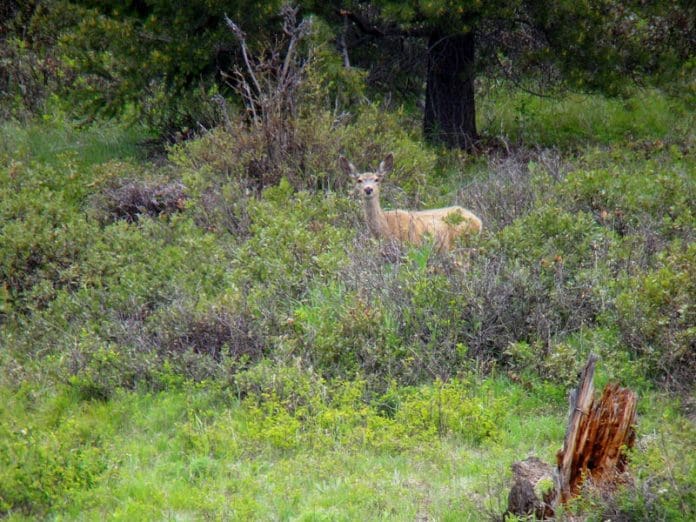Hunting for Photos:
by Matt Cashell
The modern backcountry hunter doesn’t start hunting on opening day. For many, opening day is the beginning of the end. They have spent days, weekends, and even weeks in the backcountry filling up their “hit list” with animals of suitable quality to justify punching their tag.
The best way to document this scouting is through photo and video documentation. The hunter can use these images and videos later for evaluating the animals and motivation for the upcoming hunt. The problem is, the scouting hunter doesn’t want to disturb his prey before the season, so long-range shots are the norm.
Hauling a professional DLSR camera and a $14,000 10 pound 800mm Canon L lens 8 miles into the backcountry isn’t practical for the scouting hunter, so some way to get longer focal lengths with reasonable picture and video quality is necessary.
Digiscoping:

Mule deer doe at 400 yards
Digiscoping alleviates these problems. Depending on the equipment choices, the scouting hunter can get everything into the deep backcountry that is needed for good scouting photos in a couple of pounds. Digiscoping is the technique of taking photographs and video THROUGH a sporting optic. Typically this is through a spotting scope.
Anybody can do it, you just hold up a digital camera lens to the exit pupil of the scope, half-press the shutter to let the camera’s contrast autofocus to work, and capture a photo. There are tons of adapters available for digiscoping use. They usually allow for some mechanical alignment of the camera lens and the spotting scope eyepiece, to make for more precise, steady photos.
Vignetting:

Vignetting
Vignetting is the effect that occurs where there is the black area surrounding the image circle. This can be eliminated by spacing the camera lens and eyepiece correctly, zooming a compact camera (more later), or finding the right focal length lens for an interchangeable lens camera.
Scopes:

Big objectives help the digiscoper
Large objectives and exit pupils are usefull in digiscoping. When you are taking a photo through a sport optic, you are trying to get as much light to the camera sensor as you can. This allows you to get the fastest shutter speeds to get clean, sharp pics. This is especially important in low light. I have taken suitable digiscoping photos with all three common spotter sizes: 50mm, 65mm, and 85mm. I consistently get my fastest shutter times and best photos with the 85mm.
Spotters utilizing some sort of Chromatic Aberration (CA) – controlling glass (ED, FL, HD, APO, etc.) are the best choices for digiscoping. The human brain is good at ignoring color fringing from CA in the image while viewing. Digital camera sensors are not. A spotter that provides an image with low levels of CA will provide the best photos.
Cameras:

Different types of cameras will work for digiscoping
Many cameras will work for digiscoping, but some are better than others:
DLSRs will work, and work well, depending on your setup. You will want a lens with a 35mm equivalent focal length somewhere from 50mm to 100mm. Some of the “kit” zooms sold with DSLRs work well for digiscoping, but some do not. Also you want internal focus lenses if you are using an adapter that threads to the filter threads, otherwise the camera will spin, or the lens will extend or contract when trying to autofocus.
Compact Cameras are great for digiscoping. I have found this avenue is the easiest way to get quality pics. A compact camera is also lightweight and portable. Just remember to get a camera with a MAXIMUM zoom of 5x or less. If you get a “super-zoom” camera, it will vignette badly through most of the zoom.
Video camcorders can work also, but aren’t ideal with their higher maximum zoom capabilities. Some camcorders will eliminate vignetting, but the focal length is so long by the time the vignetting is gone that it is hard to get steady footage.
Adapters:

Tines Up Video ScopeCam next to swinging bracket “contraption”
There are a lot of different adapters out there. Some attach to the scope’s eyepiece, some to their own bracket, and others to a tripod QR plate. Some are “universal” contraptions, and others are proprietary for certain scopes, and even sometimes certain cameras. Some of the big bracket style adapters swing out of the way, so you can use the spotter for viewing, and swing the camera back to the eyepiece for photography.
I have used some of each type, and I like the over-the-eyepiece style best. Vortex, Swarovski, Kowa, and others make adapters that screw onto the filter threads for the camera. The adapter also has an over-the eyepiece bracket that affixes to the eyepiece. The user then mounts the camera side of the adapter to the eyepiece side and tightens a set screw. These adapters provide for excellent stability, and they are easy to get the camera lens lined up with the exit pupil.
Lately, though, the ease of use of the Tines Up ScopeCam adapter has led me to use it almost exclusively. The ScopeCam adapter is an over-the-eyepiece adapter, but doesn’t have a part that affixes to the eyepiece. Tines Up makes adapters sized precisely for the eyepieces of popular spotters, and will custom make one based on your measurements, if your spotter isn’t in their list. These adapters just make a friction fit over the existing eyepiece and are threaded for either 37mm or 58mm. Step adapters are available to make the adapters work for all sorts of filter threading sizes. Tines Up also sells an all-in-one point and shoot kit. This kit is ready to go for quality digiscoping right out of the box. However, I use a Sony WX-1 camera with a 37mm Video ScopeCam adapter. In order to get the 37mm threading on my camera, I use a Zeikos Universal Accessory Adapter. This setup is relatively small and light, gives good pictures, and surprisingly good video.
Tips for digiscoping:
With digiscoping it is all about getting as much light to the camera’s sensor you can. This gives the best shutter times. Ways to get a lot of light to your sensor include keeping the spotter eyepiece at its lowest magnification, keeping the camera lens at the lowest zoom required to eliminate vignetting, use the Aperture Priority mode on your camera (if it has one) and set the aperture to its largest available setting (lowest f-number).
Use the macro setting on your camera, if it has one. The macro function often helps the camera focus on the image the spotter is providing, rather than trying to focus on the object through the spotter.
Besides getting light to the sensor, digiscoping requires a steady image. Digiscoping setups can produce effective focal lengths of 2000-4000 mm, so tiny amounts of shake can disturbe the photo. The result is blurry pics. Ways to reduce shake include using a shutter cable release or timer, and using a steady tripod. When I am scouting I don’t usually have a rifle or bow with me, and a heavier tripod helps get the weight and bulk of my pack closer to my hunting pack. It also really helps get quality digiscoping pics and video.

Bull elk at 1400 yards



















